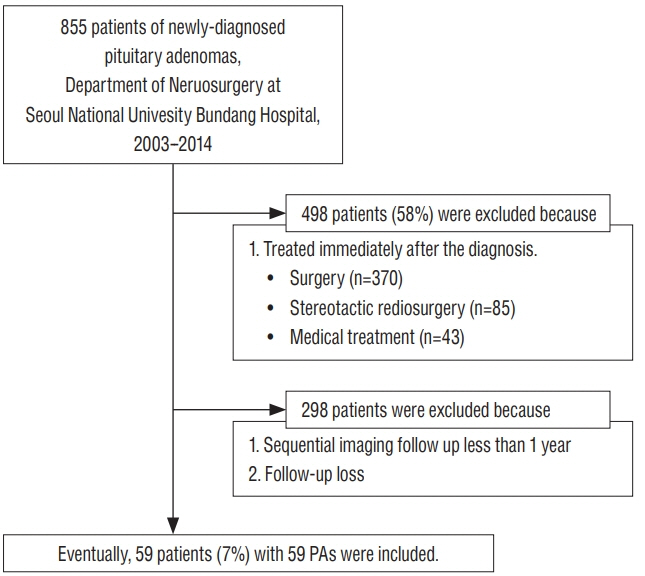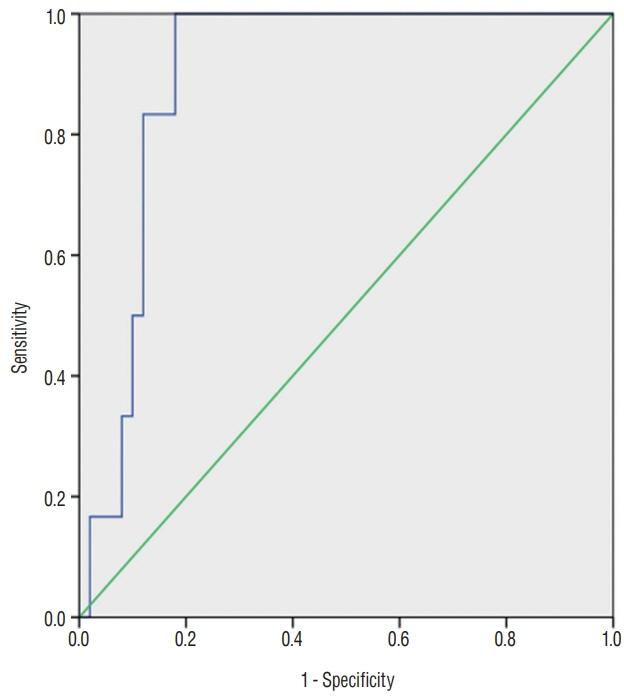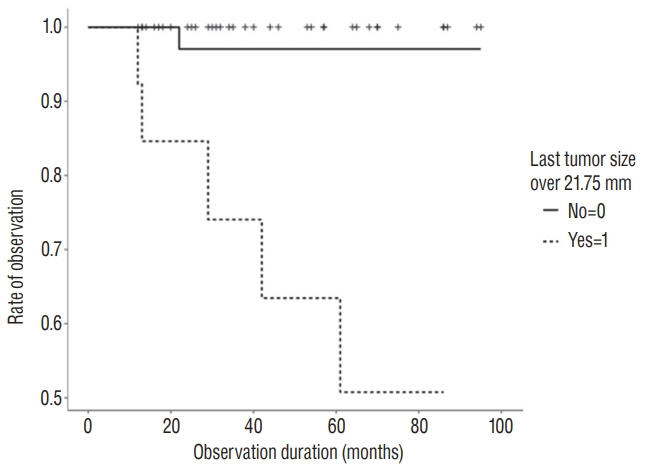J Korean Neurosurg Soc.
2019 Mar;62(2):256-262. 10.3340/jkns.2018.0153.
Growth Pattern and Prognostic Factors of Untreated Nonfunctioning Pituitary Adenomas
- Affiliations
-
- 1Department of Neurosurgery, Seoul National University Bundang Hospital, Seongnam, Korea. chaeyong@snu.ac.kr
- 2Department of Neurosurgery, Seoul National University College of Medicine, Seoul, Korea.
- 3Department of Neurosurgery, The Univerisity of Edinburgh Edinburgh Medical School, Edinburgh, UK.
- 4Department of Neurosurgery, Jeju National University Hospital, Jeju, Korea.
- KMID: 2441570
- DOI: http://doi.org/10.3340/jkns.2018.0153
Abstract
OBJECTIVE
Pituitary adenomas (PAs) are often detected as incidental findings. However, the natural history remains unclear. The objective of this study was to evaluate the natural history and growth pattern of untreated PAs.
METHODS
Between 2003 and 2014, 59 PAs were managed with clinico-radiological follow up for longer than 12 months without any kind of therapeutic intervention. Tumor volumes were calculated at initial and last follow-up visit, and tumor growth during the observation period was determined. Data were analyzed according to clinical and imaging characteristics.
RESULTS
The mean initial and last tumor volume and diameter were 1.83±2.97 mL and 13.77±6.45 mm, 2.85±4.47 mL and 15.75±8.08 mm, respectively. The mean annual tumor growth rate was 0.33±0.68 mL/year during a mean observation period of 46.8±32.1 months. Sixteen (27%) PAs showed tumor growth. The initial tumor size (HR, 1.140; 95% confidence interval, 1.003-1.295; p=0.045) was the independent predictive factor that determined the tumor growth. Six patients (11%) of 56 conservatively managed non-symptomatic PAs underwent resection for aggravating visual symptoms with mean interval of 34.5 months from diagnosis. By Cox regression analysis, PAs of last longest diameter over 21.75 mm were a significant prognostic factor for eventual treatment.
CONCLUSION
The initial tumor size of PAs was independently associated with the tumor growth. Six patients (11%) of conservatively managed PAs were likely to be treated eventually. PAs of last follow-up longest diameter over 21.75 mm were a significant prognostic factor for treatment. Further studies with a large series are required to determine treatment strategy.
MeSH Terms
Figure
Reference
-
References
1. Anagnostis P, Adamidou F, Polyzos SA, Efstathiadou Z, Panagiotou A, Kita M. Non-functioning pituitary adenomas: a single center experience. Exp Clin Endocrinol Diabetes. 119:314–319. 2011.
Article2. Arita K, Tominaga A, Sugiyama K, Eguchi K, Iida K, Sumida M, et al. Natural course of incidentally found nonfunctioning pituitary adenoma, with special reference to pituitary apoplexy during follow-up examination. J Neurosurg. 104:884–891. 2006.
Article3. Chacko AG, Chandy MJ. Incidental pituitary macroadenomas. Br J Neurosurg. 6:233–236. 1992.
Article4. Costello RT. Subclinical adenoma of the pituitary gland. Am J Pathol. 12:205–216.1. 1936.5. Dekkers OM, Hammer S, de Keizer RJ, Roelfsema F, Schutte PJ, Smit JW, et al. The natural course of non-functioning pituitary macroadenomas. Eur J Endocrinol. 156:217–224. 2007.
Article6. Donovan LE, Corenblum B. The natural history of the pituitary incidentaloma. Arch Intern Med. 155:181–183. 1995.
Article7. Fernandez-Balsells MM, Murad MH, Barwise A, Gallegos-Orozco JF, Paul A, Lane MA, et al. Natural history of nonfunctioning pituitary adenomas and incidentalomas: a systematic review and metaanalysis. J Clin Endocrinol Metab. 96:905–912. 2011.
Article8. Freda PU, Beckers AM, Katznelson L, Molitch ME, Montori VM, Post KD, et al. Pituitary incidentaloma: an endocrine society clinical practice guideline. J Clin Endocrinol Metab. 96:894–904. 2011.
Article9. Greenman Y, Stern N. Non-functioning pituitary adenomas. Best Pract Res Clin Endocrinol Metab. 23:625–638. 2009.
Article10. Hall WA, Luciano MG, Doppman JL, Patronas NJ, Oldfield EH. Pituitary magnetic resonance imaging in normal human volunteers: occult adenomas in the general population. Ann Intern Med. 120:817–820. 1994.
Article11. Honegger J, Zimmermann S, Psaras T, Petrick M, Mittelbronn M, Ernemann U, et al. Growth modelling of non-functioning pituitary adenomas in patients referred for surgery. Eur J Endocrinol. 158:287–294. 2008.
Article12. Imran SA, Yip CE, Papneja N, Aldahmani K, Mohammad S, Imran F, et al. Analysis and natural history of pituitary incidentalomas. Eur J Endocrinol. 175:1–9. 2016.
Article13. Karamouzis I, Berardelli R, Prencipe N, Berton A, Bona C, Stura G, et al. Retrospective observational analysis of non-irradiated non-functioning pituitary adenomas. J Endocrinol Invest. 38:1191–1197. 2015.
Article14. Karavitaki N, Collison K, Halliday J, Byrne JV, Price P, Cudlip S, et al. What is the natural history of nonoperated nonfunctioning pituitary adenomas? Clinical Endocrinol (Oxf). 67:938–943. 2007.
Article15. Lania A, Beck-Peccoz P. Pituitary incidentalomas. Best Pract Res Clin Endocrinol Metab. 26:395–403. 2012.
Article16. Marsden JE, Tromba AJ. Vector calculus, ed 3. New York: W H Freeman & Co (Sd);1988. p. p241.17. Orija IB, Weil RJ, Hamrahian AH. Pituitary incidentaloma. Best Pract Res Clin Endocrinol Metab. 26:47–68. 2012.
Article18. Reincke M, Allolio B, Saeger W, Menzel J, Winkelmann W. The ‘incidentaloma’ of the pituitary gland. Is neurosurgery required? JAMA. 263:2772–2776. 1990.
Article19. Sanno N, Oyama K, Tahara S, Teramoto A, Kato Y. A survey of pituitary incidentaloma in Japan. Eur J Endocrinol. 149:123–127. 2003.
Article20. Teramoto A, Hirakawa K, Sanno N, Osamura Y. Incidental pituitary lesions in 1,000 unselected autopsy specimens. Radiology. 193:161–164. 1994.
Article21. Varughese JK, Wentzel-Larsen T, Vassbotn F, Moen G, Lund-Johansen M. Analysis of vestibular schwannoma size in multiple dimensions: a comparative cohort study of different measurement techniques. Clin Otolaryngol. 35:97–103. 2010.
Article
- Full Text Links
- Actions
-
Cited
- CITED
-
- Close
- Share
- Similar articles
-
- Pituitary Adenomas in Childhood and Adolescence
- Deliberate Two-Staged Endoscopic Endonasal Transsphenoidal Surgery in Large Pituitary Adenomas
- Surgical Results of 80 Patients with Growth Hormone-Producing Pituitary Adenomas : Analysis of Outcome and Prognostic Factors
- Comparative evaluation of CT and secreting hormones in pituitary adenomas
- The Molecular Pathogenesis of Pituitary Adenomas: An Update




